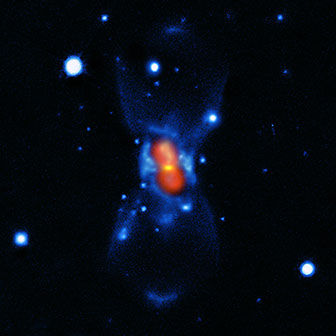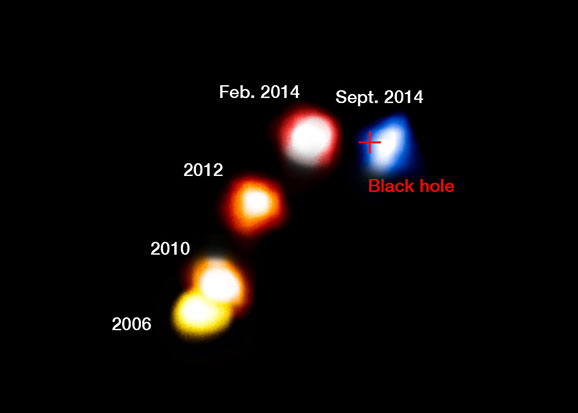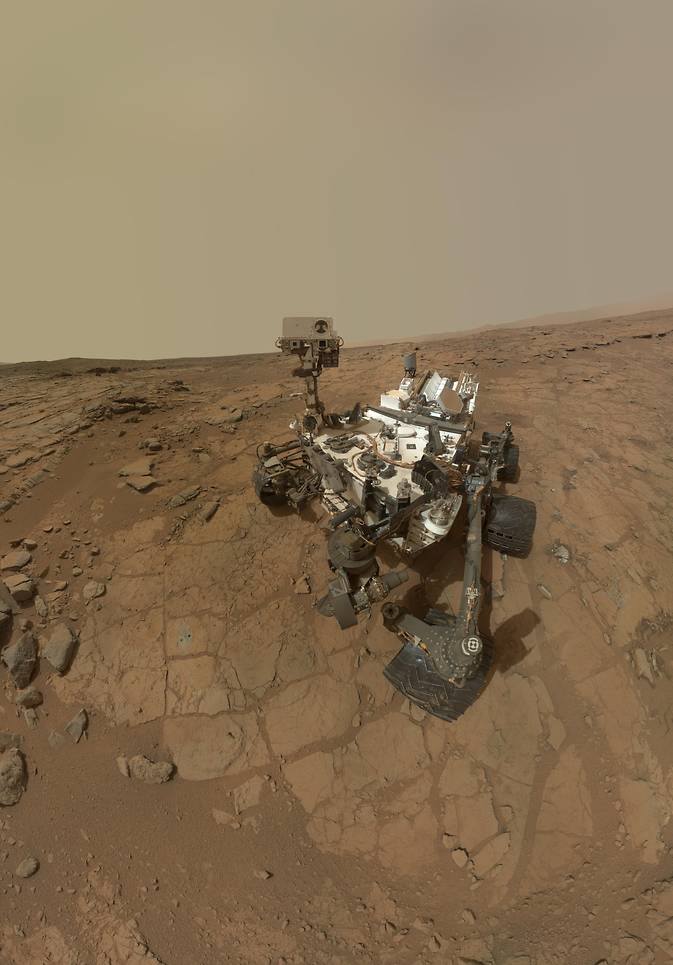

April 2015
When Stars Collide
In 1670 a new star appeared in the night sky in the constellation Vulpecula. Astronomers carefully studied it as its brightness varied over the course of two years. Then it disappeared. Then reappeared. Twice it disappeared and reappeared again, finally disappearing for good. It was determined that it was a star that went nova, an exploding star. But where was the nebula that should have resulted from the explosion. Also, why did the star appear and disappear so many times? A mystery that has lasted over 340 years began.
In the 1980's a faint nebula was found. But even instruments of that day were not enough to solve the mystery.
Today astronomers have been studying the remnant, known as Nova Vul 1670, in the submillimeter wavelengths. They have been using ESO's Atacama Pathfinder Experiment telescope (APEX) in Chile along with the Submillimeter Array (SMA) and the Effeisberg radio telescope. Astronomers have discovered that the mass of cool material was too great to be from a nova explosion. They measured the isotope ratios around Nova Vul 1670 and found they were also different from the ratios found in a nova. The explosion was more brilliant than a nova but less brilliant than a supernova. Putting all the evidence together revealed that Nova Vul 1670 was produced by two stars colliding.
It is a rare event, but when two stars collide they produce a red transient. The throw off material from their interiors into space. This leaves a faint remnant of a cool environment rich in molecules and dust. This is what happened, and was witnessed in 1670.
Credit: ESO/T. Kamiński
Clues to Dark Matter
Dark matter does not slow down when it collides with itself. These are the latest observations using the Hubble Space Telescope and the Chandra X-ray Space Observatory.
Dark matter cannot be seen. It does not reflect, absorb or emit light. But we know it is there because of how its gravity affects other objects. Scientists use a method called gravitational lensing to measure how much space is warped when dark matter interacts with objects. The light from distant objects is magnified and distorted due to the gravity of dark matter.
The best place to view this is in galaxy clusters. Here, galaxies are colliding and interacting with each other. Seventy two large cluster collisions were studied. The collisions occurred at different times and were seen at different angles. By putting all the data together, scientists are able to paint a better picture of how dark matter behaves.
Scientists found that the dark matter continued straight through the collisions without slowing down much. If the dark matter had any impact on other dark matter, the distribution of the galaxies would have shifted.
This new data can now eliminate some of the theories of what dark matter can be. Now particle physicists can narrow the number of unknowns when developing their theories. We are getting closer to an answer, but still have a long way to go before we understand this invisible matter that makes up most of the universe.
Aurora on Mars
NASA's Mars Atmosphere and Volatile Evolution (MAVEN) spacecraft has observed an aurora in the Martian atmosphere and an unexplained high-altitude dust cloud.
The aurora appeared for five days just before Christmas. MAVEN detected a huge surge in electrons from the sun just before the aurora began. As these energetic electrons interact with the atmosphere they cause the gas to glow. This is how we get the northern and southern lights on Earth.
The aurora on Mars traveled very deep into the atmosphere. Unlike on Earth, Mars lost its protective magnetic field billions of years ago, so the solar particles can strike the Martian atmosphere directly.
The high-altitude dust cloud is a mystery. It occurred from about 93 miles (150 km) to 190 miles (300 km) above the surface. What the dust is made of and where it came from is unknown. The dust may have come up from the surface, or be coming from the moons Phobos and Deimos, or coming from the solar wind, or could be debris from comets. But no known Martian process can account for it.
Cloud Survives Passing Black Hole
ESO's Very Large Telescope (VLT) in Chile has confirmed a dusty gas cloud known as G2 has made it past a black hole intact. The black hole is the supermassive black hole found at the center of the Milky Way.
Scientists have been tracking G2 for years as it moved closer and closer to the black hole. It was expected that the forces of the black hole would stretch and tear the cloud apart. As this happened, activity in the black hole would be detected. Many telescopes around the world awaited the event. But as G2 made its closest approach in May 2014, nothing happened. G2 had been traveling away from Earth at 10 million kilometers per hour and after it swung around the black hole it is now heading toward Earth at 12 million kilometers per hour, gaining speed from the gravitational slingshot effect.
But why did G2 survive? Why did it not get obliterated? One answer may be that G2 is not just a cloud of gas. Inside G2 may lay a young star. This young star would have enough gravity and mass of its own to avoid being torn apart at that distance from the black hole.
The latest observations have not detected any increased activity in the black hole and G2 is still intact and not significantly stretched or deformed.

False color of G2 going around black hole, red is away from Earth, blue is toward Earth. Red cross is location of black hole.
Credit: ESO/A. Eckart
Visit our sponsors.


For advertising opportunities on this page and our videos, contact
Upcoming Launches
Date: April 13
Launch Vehicle: SpaceX
Launch Site: Cape Canaveral Air Force Station, Florida
Description: Resupply mission to the International Space Station
Date: April 28
Launch Vehicle: Soyuz
Launch Site: Baikonur Cosmodrome, Kazakhstan
Description: Progress 59P Cargo Craft. Resupply mission to the International Space Station
Clue to Galaxy Cluster Formation
ESA's Herschel and Planck space observatories are combing data to help discover how the vast galaxy clusters we see today came into being. Galaxies are usually not found by themselves in the universe, but instead are found in clusters. These clusters can consist of tens, hundreds or thousands of galaxies. But exactly how these clusters came to be is unknown.
In the early universe, stars and galaxies burst into life. At some point later they assembled into large clusters. The gravity in these clusters caused matter to collapse and star forming new stars and galaxies. Dark matter helped the process along.
To study where clusters came from, one has to look far back in time, to a point not long after the Big Bang. This was the goal of the Planck observatory, to map the cosmic background microwave radiation left over from the Big Bang. Planck surveyed the entire sky in nine different wavelengths from far-infrared to radio. This eliminated foreground emissions so Planck could see behind them and deeper back in time and space.
But the foreground objects were also of great astronomical value. With the foreground objects isolated, scientists were then able to study them separately and they identified 234 of them that were located in the distant early universe.
That is where Herschel stepped in. Looking at the objects from the far-infrared to submillimeter, with extreme sensitivity and resolution, Herschel revealed the majority of these objects were consistent with dense concentrations of galaxies in the early universe. Each of these galaxies were creating stars at incredible rates.
Scientists believe that these galaxy concentrations may be "protoclusters", the early formation of galaxy clusters. A lot of work and verification is still needed before any conclusions can be drawn, but these are the best candidates found so far.
Opportunity Runs a Marathon
They have been running marathons since ancient Greece. A race of twenty six miles. But never has anyone run a marathon on another planet. Until now. It may have been a robot to do it instead of a human, but it is still quite a feat. Opportunity has now traversed over 26 miles on Mars. Total time for the marathon: 11 years 2 months.
Last year Opportunity became the long distance record holder for off-Earth vehicles surpassing the mark set by the Soviet Union's Lunokhod 2 moon rover. Now Opportunity is the first off-Earth vehicle to complete a marathon distance. As project manager John Callas of JPL put it, "A first time happens only once." Future missions will certain go farther, but Opportunity will forever hold the distinction of being the first.
Opportunity is currently exploring the rim of Endeavour crater. There it has found ancient wet conditions that had a less acidic content, making them more favorable for microbial life.
And elsewhere on Mars.........
Curiosity has made the first detection of nitrogen on Mars. The nitrogen is in the form of nitric oxide. It was released from heating soil samples causing the breakdown of nitrates. This nitrogen is a form that is used by living organisms, providing more evidence that Mars once was a place capable of containing life. But the amount of nitrates found indicate that they were probably formed from meteorite impacts and not a biological process.

This self-portrait of NASA's Mars rover Curiosity combines dozens of exposures taken by the rover's Mars Hand Lens Imager on Feb. 3, 2013 plus three exposures taken May 10, 2013 to show two holes (in lower left quadrant) where Curiosity used its drill on the rock target "John Klein".
Image Credit: NASA/JPL-Caltech/MSSS
© 2014-2016 Ted Cook Productions LLC. - All Rights Reserved